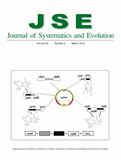Anna-Magdalena BARNISKE, Thomas BORSCH, Kai MÜLLER, Michael KRUG, Andreas WORBERG, Christoph NEINHUIS, Dietmar QUANDT
2012, 50 (2): 85–108
Recent phylogenetic analyses revealed a grade with Ranunculales, Sabiales, Proteales, Trochodendrales, and Buxales as first branching eudicots, with the respective positions of Proteales and Sabiales still lacking statistical confidence. As previous analyses of conserved plastid genes remain inconclusive, we aimed to use and evaluate a representative set of plastid introns (group I: trnL; group II: petD, rpl16, trnK) and intergenic spacers (trnL-F, petB-petD, atpB-rbcL, rps3-rpl16) in comparison to the rapidly evolving matK and slowly evolving atpB and rbcL genes. Overall patterns of microstructural mutations converged across genomic regions, underscoring the existence of a general mutational pattern throughout the plastid genome. Phylogenetic signal differed strongly between functionally and structurally different genomic regions and was highest in matK, followed by spacers, then group II and group I introns. The more conserved atpB and rbcL coding regions showed distinctly lower phylogenetic information content. Parsimony, maximum likelihood, and Bayesian phylogenetic analyses based on the combined dataset of non-coding and rapidly evolving regions (>14 000 aligned characters) converged to a backbone topology of eudicots with Ranunculales branching first, a Proteales–Sabiales clade second, followed by Trochodendrales and Buxales. Gunnerales generally appeared as sister to all remaining core eudicots with maximum support. Our results show that a small number of intron and spacer sequences allow similar insights into phylogenetic relationships of eudicots compared to datasets of many combined genes. The non-coding proportion of the plastid genome thus can be considered an important information source for plastid phylogenomics.










